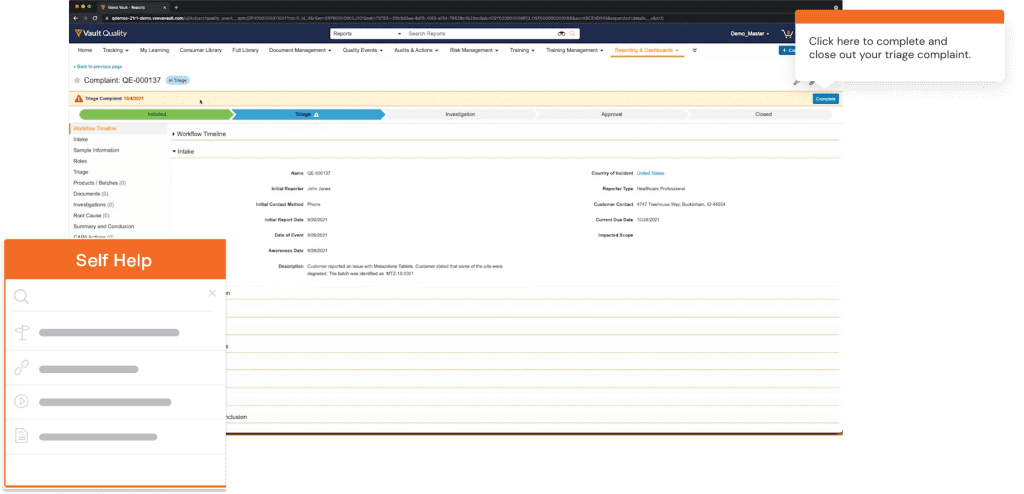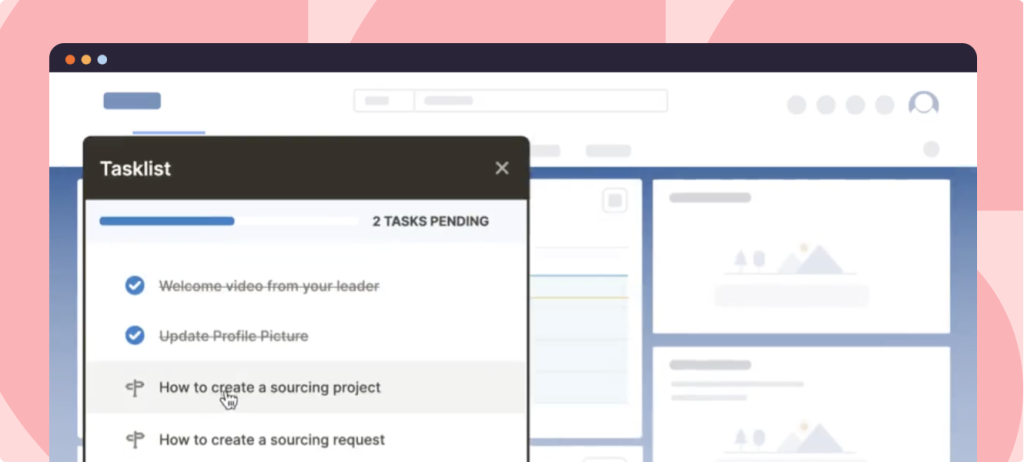Veeva Systems is an American cloud-computing company that builds software products for pharmaceutical and life sciences industry applications. It offers a wide range of industry-specific technology solutions for enterprise pharmaceuticals, biotech, and life science companies, such as:
- All-in-one clinical ops management stack, including EDC, coding, eTMF, payments, etc.
- A regulatory information management hub for faster GTM (Veeva Vault RIM).
- Process-wide quality management, from role-based training to issue escalations (Vault Quality).
- Adverse event tracking for observing interactions/contraindications during trials (Vault Safety).
- An expert network for consulting Key Opinion Leaders and Healthcare Providers (Medical Suite).
- An industry-compliant communication platform that offers medical practices CRM, CMS, email, event management services, automated medical inquiries, etc. (Commercial Cloud).
But, perhaps, Veeva’s most significant USP for life science and pharmaceutical operators is its quality management (QMS) software suite that empowers its customers and end-users to manage and control their documentation, stay compliant with industry standards (e.g., GMP, i.e., Good Manufacturing Practices, GLP, i.e., Good Laboratory Practices, and GCP, i.e., Good Clinical Practices), coordinate their Corrective and Preventive Actions workflow, manage suppliers, and keep tabs on quality metrics.
Veeva QMS is designed to help life science and pharmaceutical companies manage their quality control and compliance processes more effectively. Veeva’s QMS is branded as Vault and we use both terms interchangeably throughout this article.
If you’re reading this, you’re on the cusp of investing in Veeva’s Vault QMS and this article will give you a handy guide to help you accelerate your QMS implementation and drive end-user adoption across your wider team.
What are the eight steps for a successful Veeva QMS implementation?
- Meet with key organizational stakeholders
- Set goals and desired outcomes from Veeva QMS implementation
- Define Veeva QMS system requirements and configurations
- Map QMS-related business processes
- Plan an organizational change strategy
- Invest in employee training and QMS onboarding
- Enable Veeva QMS end-users with on-demand performance support and IT support
- Collect feedback from Veeva QMS end-users
- Use user behavior and product analytics to optimize Veeva processes and identify friction points
8 Steps for a Successful Veeva QMS Implementation
To understand what it takes to implement a Veeva QMS instance successfully, you must start thinking backward – how can you inject technology into your organization’s existing workflows? Where can automation help you reduce error rates and ensure compliance?
That’s why your implementation strategy needs to start with front-line stakeholders, rely on an -in-depth knowledge of your existing processes, and be heavy on training and development to help your workforce use the platform to its full potential.
1. Meet with key organizational stakeholders to define QMS system requirements and configurations
Life sciences, pharma, and biotechnology are heavily empirical fields—the bulk of the work is frontline research and there are few layers of managerial oversight and hierarchy. And those researchers will be dealing with your QMS, trying to align it with their existing workflows. Consequently, your QMS implementation journey needs to start with a consultation and engaging with these stakeholders to help you determine:
- Their compliance needs, desired changes to your existing quality processes, etc.
- Which modules and features of Veeva QMS are relevant to your organization, such as document management, change control, CAPA, supplier quality management, and training management?
- User roles and permissions to ensure that the right individuals have the appropriate access to the system.
- Whether Veeva QMS needs to integrate with other tools in their stack, such as ERP or laboratory information management systems (LIMS), etc.
2. Set goals and desired outcomes from Veeva QMS implementation
What are your goals for your Vault QMS implementation? Setting these targets, along with metrics for measuring success will help you determine how to customize your Vault QMS to suit your uses and any edge cases to account for.
Depending on your organization’s size, industry, or projects, you might be trying to:
- Create a scalable system for ensuring compliance with industry regulations (e.g., FDA, EMA, ISO).
- Adopt a reliable system of record for quality documentation and managing SOPs and batch records.
- Streamline your change management process to ensure procedures, specifications, and processes are properly reviewed, approved, and documented.
- Facilitate the investigation of root causes and the implementation of corrective actions to prevent recurrence.
- Ensure your suppliers meet quality standards, etc.
3. Map QMS-related business processes
Document your existing QMS-related processes, workflows, and SOPs in their current iterations, ranging from change control to Corrective and Preventive Actions (CAPA). Your goal at this stage is twofold: first, you want to examine all your processes, identify growth opportunities, and eliminate redundancies; secondly, you want to optimize them for a digital quality management workflow, especially to fit the parameters for Veeva’s Vault QMS.
4. Plan an organizational change strategy
Your organizational change strategy is your game plan for securing buy-in across the board, educating your team on why you’re switching to Veeva’s Vault QMS, and creating the infrastructure to ensure a smooth rollout. Among others, you need to:
- Align with stakeholders and department leads to endorse the project and advise on best practices.
- Nominate staff across departments to serve as change champions that’ll promote the QMS and carry the rest of their team along.
- Develop a clear and consistent change communication plan. Regularly update employees about the implementation’s progress, goals, and expected outcomes.
- Roll out the QMS in a limited pilot program so you can get frontline feedback and use it to tweak the QMS before an organization-wide implementation.
- Draft a risk mitigation plan for addressing potential challenges and uncertainties during the transition phase.
During the transition phase, you’re trying to keep your day-to-day operations running (on your existing systems) while slowly navigating the core of your quality management ops to Veeva—almost like fixing an aircraft engine in mid-air. That’s why you need a change management strategy: it helps account for possible disruptions and creates a minimally viable plan for mitigating them when they occur.
5. Invest in employee training and QMS onboarding
The human factor is easily the most unpredictable when working with enterprise software—especially when transitioning between different platforms. When you’re adopting a new quality management system, it’s doubly so: your employees are most likely invested in the software implementation process, advising on best practices, and helping design the vision for the new QMS, while attending to their regular day-to-day duties.
There’s the possibility that they might miss helpful information and thus not be able to use the platform to its full potential. Thankfully, there are countless approaches you can take towards investing in employee onboarding and continuous end-user training such as:
- Onsite workshops, seminars, or hands-on sessions with Vault QMS implementation partners.
- Certification: Veeva offers a handful of courses to explain how their entire product suite works for users across the different roles/learning paths Vaut QMS supports.
- In-app guidance: Enriching your Vault QMS UI with onboarding cues and aids, such as hotspots, tooltips, walkthroughs, and on-demand content that guides users along non-intrusively.
- Veeva official resources, like knowledge base articles, official communities, and other onboarding and training resources from Veeva.
With a digital adoption platform (DAP) like Whatfix, IT teams can accelerate Veeva QMS adoption by enabling end-users with in-app guided onboarding flows and continuous interactive training right inside of the Veeva UI.

With Whatfix’s no-code editor, easily create contextual guided walkthroughs (Flows), in-app checklists (Task Lists), Pop-Ups, Field Validations, Smart Tips, Beacons, and more – all enabling your Veeva QMS end-users with interactive, contextual, moment-of-need support and reinforcement learning for different types of end-users, depending on their role and where they are in Veeva.
6. Enable Veeva QMS end-users with on-demand performance support, help documentation, and IT support
After your initial deployment, you can take your Veeva QMS a step further by integrating third-party product adoption tools like Whatfix to help you coach your end-users, offer contextual end-user support, embed helpful resources (wikis, product docs, FAQs) right inside your Vault QMS interface.
With a DAP like Whatfix, IT teams can provide real-time Veeva end-user support with Self Help. Self Help connects, crawls, and aggregates all of your organization’s online storage and drives, internal wikis, QMS-related process documentation, end-user onboarding and training materials, IT help desk and related knowledge articles, video and screen recording tutorials, third-party links and resources from Veeva, and more – and then organizes them in a searchable Self Help widget that overlays on your Veeva QMS’s UI.


→ Guide users through complex apps with contextual, role-based in-app guidance.
→ Support users at the moment of need with AI-powered Self Help and embedded workflow assistance.
→ Analyze user engagement to identify friction points and optimize business processes.
7. Collect feedback from Veeva QMS end-users
End-users ranging from QA specialists to operations managers, to suppliers are the best proxy for measuring the effectiveness of your newly implemented QMS and vetting and where you need to make changes to fit your organization’s needs.
Feedback is essential during your initial beta launch of Veeva, allowing those end-users who are first interacting with your Veeva QMS instance to report bugs, provide feedback on the usability of processes, request additional training or support on different workflows, and more.
End-user feedback should be collected throughout the lifecycle of your new Veeva QMS investment and helps determine how to customize your QMS further and design your user training and onboarding programs to suit hands-on use cases better. It can specifically help answer the following Veeva-related questions:
- How has the introduction of the new QMS impacted your day-to-day work and responsibilities?
- Can you describe any specific challenges or difficulties you encountered using the QMS?
- Have you received adequate training and support for using the QMS effectively?
- What do you find most beneficial or valuable about the new QMS in your role?
- Are there any features or functionalities of the QMS that you believe could be improved or enhanced?
- Have you noticed any improvements in terms of document control and accessibility since the QMS was deployed?
- How would you rate the user-friendliness and ease of navigation of the QMS interface?
- Have you been able to access the information and data you need more quickly and efficiently with the QMS?
- In your experience, how well has the QMS supported compliance with regulatory requirements and quality standards?
- Have you utilized the QMS for tasks like change control, CAPA, or supplier management, and if so, how has it affected those processes?
- Are there any areas where you feel additional training or resources would be beneficial to help you make the most of the QMS?
- How has the QMS impacted collaboration and communication within your team or department?
With a DAP like Whatfix, CIOs and IT teams can create and embed in-app surveys to collect end-user feedback right inside Veeva QMS. This enables IT teams to collect qualitative feedback from real Veeva QMS end-users directly inside the application.

8. Use user behavior and product analytics to optimize Veeva processes and identify friction points
More than just quizzing your end-users to learn what they love and what they think could be improved, behavior analytics helps you observe their usage patterns, down to the features they use, pages they visit, and the UI elements they interact with within the Veeva ecosystem.
Using that data you can go a step further and accurately identify where your end-users face issues, common friction points, UI confusions, and usability challenges.
A product analytics platform like Whatfix helps IT teams understand how end-users are engaging, using, and adopting your new Veeva QMS investment with user behavioral analytics.
This data-driven approach to end-user adoption enables IT teams to map user flows, build the most efficient processes, identify end-user friction points, and extract data that provides actionable insights to make your QMS user experience and workflows as intuitive for users that enables them to maximize their productivity with the platform, regardless of their technical abilities.
How to Drive Veeva QMS End-User Adoption With Whatfix
Read through all the QMS implementation tips we shared above carefully. You’ll find that user adoption is a recurring theme: after all, it doesn’t matter how much you invest into deploying a QMS (or CRM, ERP, LMS, etc.) if your workforce doesn’t have the training and ongoing coaching required to make sense of the functionality the platform offers and resolve issues on-demand, without jumping through lengthy hoops.
That’s the question Whatfix: our user adoption platform helps enterprises roll out new software platforms across their organization, design role-based learning paths for each staff, and create a library of on-demand guidance resources users can engage at their own pace, including:
- Contextual in-app guidance with step-by-step product tours, user flows, and onboarding task lists that gamify the ‘new user’ experience.
- Smart tips, UI beacons, pop-ups and field validation alerts that highlight errors and best practices.
- A self-help hub embedded inside the Vault QMS interface, from where users can search through your library of relevant FAQs, wikis, pre-recorded explainers, etc., right at the point of need.
- Multi-format surveys (including 1 to 10 ratings and free text fields) that allow you to learn what your end-users think about the Vault QMS experience.
- Powerful product analytics for tracking user behavior and UI interactions to detect friction, issues, and custom events.
Vault is easily the most powerful quality management stack designed specifically for biotech/pharma/life sciences. It has such a comprehensive stack of features that it can get in the way of non-technical or inexperienced users. Whatfix adds a personalized 1:1 guidance layer on top of your Vault QMS instance to coach each of your end-users and unlock the platform’s full power.




